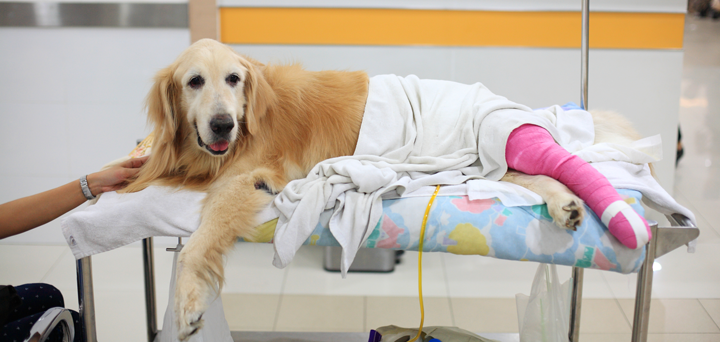Overview

What is a cruciate ligament injury?
A cruciate ligament injury is damage to one (or both) of the cruciate ligaments, either a small tear or a complete rupture.
Some cruciate ligaments break after being weakened over time (like a fraying rope), and some rupture suddenly (often due to a knock or fall).
This illustration is showing cruciate damage: it is either a little tear or a complete break in the ligament.

What are the symptoms of pets with cruciate damage?
Cruciate ligament damage can cause symptoms that vary from a slight limp to being unable to put any weight on the leg at all. Symptoms often come on quite suddenly and include:
This illustration shows the location of the cruciate ligament in dogs: it is found in a dog’s knee.

Which breeds are at risk of cruciate disease?
Cruciate injuries can develop in any dog, but there are certain breeds (such as the Labrador, Rottweiler, and Newfoundland) that are slightly more at risk. However, dogs most at risk of injury are those that are overweight, and those that tear around on uneven ground, chasing, turning quickly, skidding, and jumping.
When to contact your vet?
Contact your vet if your dog is limping or you suspect they may have a cruciate ligament injury.
How does the veterinarian diagnoses it?
To diagnose cruciate disease your vet will feel for abnormal movement in the knee joint and take X-rays.
What are the treatment options?
Some cruciate injuries need surgery and some can be treated without, your vet will help you decide which option is best for you and your dog.
Without surgery (‘conservative treatment’)
Treatment without surgery (‘conservative treatment’) relies on building extra strength around the knee to take the strain off the cruciate ligaments. This type of treatment is mostly used in dogs that weigh less than 10kg and dogs with mild signs. Treatment usually includes:
Conservative treatment often takes a few weeks to a few months but if it’s not successful or suitable, surgery may be recommended.
Surgery
There are a few different surgical options for cruciate disease. The best option will depend on your dog’s weight and size, and whether referral to a specialist surgeon is an option. Speak to your vet for more information.
After surgery, your dog will need to recover for several weeks. They will need pain relief, strict rest, and a very gradual and controlled return to exercise. Your vet will give you specific instructions tailored to your dog – it’s vitally important to follow these to make sure that your dog has the best chance of recovery.
What are the ongoing care and outlook?
With treatment and a good recovery, your dog will likely return to living a relatively normal life. However, around one-third of dogs who have had a cruciate ligament injury, develop a similar problem in the other knee at some point later in their life, so it’s important to protect them from injuring themselves again by:
Sensible exercise
Once your dog has recovered, normal walking and running is fine but they should avoid very strenuous activities such as ball chasing, jumping, and skidding.
Weight control
It’s important to keep your dog fit and slim to avoid putting unnecessary pressure on their joints and to slow the development of arthritis later in life.
Arthritis
Dogs who have had cruciate ligament damage nearly always develop arthritis later in life. For this reason, your vet will recommend regular check-ups and possibly joint supplements.
How to prevent cruciate disease?
The two best things you can do to prevent cruciate problems in your dog is to:

| Cookie | Duration | Description |
|---|---|---|
| cookielawinfo-checkbox-analytics | 11 months | This cookie is set by GDPR Cookie Consent plugin. The cookie is used to store the user consent for the cookies in the category "Analytics". |
| cookielawinfo-checkbox-functional | 11 months | The cookie is set by GDPR cookie consent to record the user consent for the cookies in the category "Functional". |
| cookielawinfo-checkbox-necessary | 11 months | This cookie is set by GDPR Cookie Consent plugin. The cookies is used to store the user consent for the cookies in the category "Necessary". |
| cookielawinfo-checkbox-others | 11 months | This cookie is set by GDPR Cookie Consent plugin. The cookie is used to store the user consent for the cookies in the category "Other. |
| cookielawinfo-checkbox-performance | 11 months | This cookie is set by GDPR Cookie Consent plugin. The cookie is used to store the user consent for the cookies in the category "Performance". |
| viewed_cookie_policy | 11 months | The cookie is set by the GDPR Cookie Consent plugin and is used to store whether or not user has consented to the use of cookies. It does not store any personal data. |
Create an account or sign in to save pets you love.
Don't have an account? Contact us
Before you proceed with your adoption application, please review and accept our data handling practices:
Note: By clicking "I Agree & Continue", you will be redirected to an external application form. This tracking system logs your interest but does not capture data from the external form.